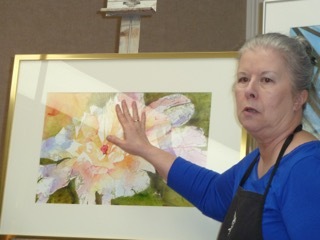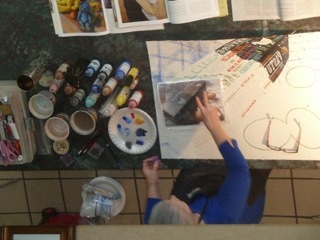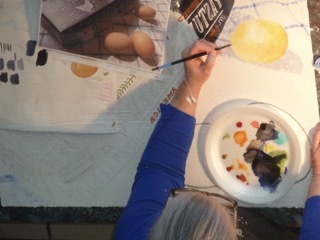PROGRAM - MARCH 1, 2017 - FLUID ACRYLICS AS WATERCOLOR
March Program – Deb Ward
Fluid Acrylics as Watercolor
March 1, 2017
.png)

Claudia Taylor, Program Chair, introduced Deb Ward, our presenter for the March meeting. Deb is from Indiana. She started working in watercolors in the mid 1990’s. She began teaching her craft in 2004. As part of this teaching, she holds seasonal classes for the Cincinnati Recreational Commission. She also teaches in workshops that she holds at her Indiana home. She has been the Viewpoint chair and is a past President of the Greater Cincinnati Watercolor Society. Deb has her Signature Status in multiple watercolor societies such as Georgia, Ohio, Pennsylvania, Indiana and the Hoosier Salon. She has been juried into shows of these societies as well as the National Watercolor Society Show. She has been published in Artist Magazine, Watercolor Artist Magazine and Acrylic Works among others.
Deb began working with fluid acrylics several years ago and subsequently was asked by the manufacturers of Chroma brand acrylics to test drive their product. She has found that she really enjoys working with this variation of the watercolor approach to her paintings. One of the biggest differences in her handling of fluid acrylics versus traditional watercolors is that she uses watercolors in a traditional manner; whites are created by leaving the paper unpainted. In her watercolors, black is also usually mixed from a variety of color mixes. However, when she uses fluid acrylics she does use white in varying degrees of opacity, from a thin glaze to full white accents. While she may still mix black, as she does in watercolor, she will also use black directly as a tint or full color in fluid acrylics.
Fluid Acrylics are similar to watercolor in that they can be applied in glazes, which is the process of layering applications of color to build up the overall effect. In fluid acrylics, the process works from light to dark, which is also similar to watercolor. The difference in this process is that once the fluid acrylic glaze or color application is dry, it cannot be rewetted, lifted or modified in any way, as one can in watercolor.
Deb illustrated her application of fluid acrylics by showing us an in progress painting she is working on with the fluid acrylics. Deb is unabashedly in love with working in great detail. Her portfolio is filled with exotic still life paintings where she composes interesting elements against very beautiful and textural fabrics and patterns.

.jpeg)
Deb uses a variety of references in her work. She gave a good piece of advice in that if one uses a “product” within a painting, one must get permission in writing. As Deb finalizes her compositions, she will transfer varying parts of her painting onto her paper by enlarging her photo images and transferring the line work.
When applying fluid acrylics, it is important to remember that fluid acrylic color holds as they appear as wet, whereas watercolor typically dries lighter than it appears when wet. Acrylic resin holds pigment color due to its binder. Acrylics can easily be glazed over with other colors. Acrylics can be applied as thin or heavy as desired. As Deb works during her painting process, she often sprays her palette of colors with water in order to keep the acrylic paints workable. Since she can’t reconstitute the colors by rewetting, Deb keeps a record of color mixes and dried examples of colors that she is using in her current painting so she can recreate colors in her painting palette. Deb has observed that some fluid acrylics appear to granulate.
Deb will evaluate the composition of the painting she is working on in order to determine the order of her painting process. She will often paint parts of the background first so she can measure the impact of her foreground elements against the background. She will also utilize liquid miskit to help control the edges of lighter elements or areas. Deb has noticed that some acrylics are thicker or different consistency than others. She admits that she has learned this through trial and error and experimenting.
During her painting process Deb explains that she has dedicated some of her paint brushes to acrylic use. Once a brush has been used for acrylics, it cannot be used for watercolors again. Deb cautions that it is very important to stay aware of the dryness of paint on one’s brush during the painting process. Acrylic paint needs to be cleaned from the brush immediately after use. Once it dries, the brush is finished. A tip from one of the club members, Helmut Kientz, suggests using Purell to help clean brushes is very effective. Deb uses a brush made by the Silver Brush Company, called “Black Velvet. This brush is a mix of synthetics and squirrel hair.
Deb stated that acrylic additive mediums can be used with fluid acrylics. Fluid Acrylics can be broken down to a 100:1 dilution and the paint will still adhere. Different fluid acrylic brands can be mixed together without any detriment. The range of fluid acrylic colors matches the range of colors available in watercolor.

As Deb continued working on her painting, she showed a variety of techniques. She applied paint color directly in a “drawing with a brush” application. She also utilized a sponge to dapple her color in order to simulate the fabric texture. She applied color wet-in wet for her egg shapes. She did confirm that acrylic colors can result in “blooms” when working wet-in-wet, if one tries to apply color before it is dry.
Deb emphasizes that as in watercolor, when working with thin acrylic glazes, one needs to do a lot of pre-planning to organize the process of layering the glaze colors. Deb explained that she also pours with fluid acrylics, although she pours selectively with a spotter in controlled areas, saving whites with miskit or tape. Deb encourages glazing as a wonderful way to introduce depth in color within a painting. Shadows in paintings should be created by utilizing a mix of colors that are already present in the painting, so they don’t stand out or look foreign to the color palette. Deb extolls the use of “dirty” water to help cut the brightness of a color or whites. She also likes to mix her own grays/blacks. One of her “go to” mixes is Ultramarine Blue with Burnt Umber.
It was enjoyable to watch Deb work through her process of painting incredibly detailed yet freshly engaging colorful paintings, that are her hallmark. We also learned a lot about the similarities and differences between watercolor and fluid acrylics. Thanks Deb.
Deb then spent time critiquing paintings that members brought in for her review. All members are welcome to bring paintings in for Critique at the conclusion of each monthly meeting.
Submitted by Tom Schroeder, GCWS Secretary

